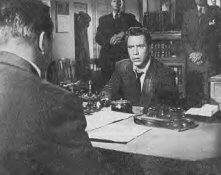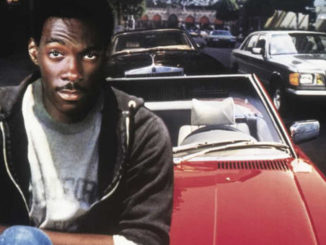 The National Film Preservation Board of the Library of Congress announced the next 25 films scheduled to be preserved by the National Film Registry. This group of “culturally, historically or aesthetically” significant titles brings the total number of films placed on the Registry to 400. The historical list includes a short film showcasing the first star of American cinema to one of the best World War II sagas ever filmed, from resonant film noir like 1950’s D.O.A. to classic comedies like Danny Kaye’s The Court Jester (1956).
The National Film Preservation Board of the Library of Congress announced the next 25 films scheduled to be preserved by the National Film Registry. This group of “culturally, historically or aesthetically” significant titles brings the total number of films placed on the Registry to 400. The historical list includes a short film showcasing the first star of American cinema to one of the best World War II sagas ever filmed, from resonant film noir like 1950’s D.O.A. to classic comedies like Danny Kaye’s The Court Jester (1956).
Librarian of Congress James H. Billington officially announced this year’s list on December 28, 2004, stating the films in the Registry represent a stunning range of American filmmaking all deserving recognition, preservation and access by future generations.
“The films we choose are not necessarily the ‘best’ American films ever made or the most famous,” Billington observed. “But they are films that continue to have cultural, historical or aesthetic significance — and in many cases represent countless other films also deserving of recognition”.
The films do not have to be feature-length or to have had a theatrical release. The Foundation’s primary mission is to save so-called “orphan films,” films without owners to pay for their preservation. The films most at-risk are newsreel, silent film, experimental work, films out of copyright protection, significant amateur footage, documentary films and features made outside the commercial mainstream and some films made by now-defunct film movie studios.
“The selection of a film, I stress, is not an endorsement of its ideology or content, but rather a recognition of the film’s importance to American film and cultural history and to history in general,” Billington notes. He adds, “The Registry stands among the finest summations of American cinema’s wondrous first century.”
This year’s earliest entry on the list is 1909’s Lady Helen’s Escapade, a D. W. Griffith directed short comedy starring Florence Lawrence (“The Biograph Girl”). Lawrence was the first film star to use her name to advertise the film company (Independent Moving Pictures Company –IMP) that she worked for. She was also the first to receive billing in film credits, a notable change from the anonymity that actors and actresses had worked in until that point. Other film companies followed suit, and film star names began to appear in all aspects of press.
Other silent films on the list include the famous Charley Bowers surrealist short, There It Is (1928), which combines live action with stop-motion object animation, and 1931’s A Bronx Morning, part documentary and part avant-garde filmed by Jay Leyda featuring an sophisticated use of European filmmaking styles. The movie won Leyda a scholarship to study with the renowned Soviet filmmaker Sergei Eisenstein.
Ben Hur (1959), starring Charlton Heston, was included as it is the first of only three films in history to win a total of 11 Academy Awards. The film is also important due to the controversy created within conservative MGM studios because homosexual overtones were discovered in script and onscreen between the Ben-Hur and Massala characters. The scenes were not cut. The film also has importance as one of the first to involve huge marketing tie-ins, including hundreds of toys as well as ‘Ben-His’ and ‘Ben-Hers’ towels. At the time Ben Hur was filmed MGM was facing bankruptcy, but the film single-handedly saved MGM.
This year’s list also includes many memorable musicals, including the 1936 George Stevens directed Rogers/Astaire vehicle Swing Time, the sentimental favorite Going My Way (1941) starring Bing Crosby, Jailhouse Rock (1956) with Elvis Presley in the ultimate rebel mode, and 1954’s Seven Brides for Seven Brothers, an Oscar winner for Best Scoring starring Jane Powell and the late Howard Keel.
The most current entry selected to the list is the cinematic masterpiece, Schindler’s List (1993). Shot in black and white with certain objects only in color, this was the first black & white film to win a Best Picture Oscar since The Apartment (1960).
The complete list of films on the National Film Registry can be found here. The films on the list range from silent classics Intolerance (1919) and It (1927) to popular block busters like Star Wars (1977) and Raiders of the Lost Ark (1981) to historically important film footage as the Hindenburg Disaster Newsreel Footage (1937) and Abraham Zapruder’s infamous home movie footage of the John F Kennedy assassination.
The complete alphabetical list of films named to the list this year is as follows-
- Ben-Hur (1959)
- The Blue Bird (1918)
- A Bronx Morning (1931)
- Clash of the Wolves (1925)
- The Court Jester (1956)
- D.O.A. (1950)
- Daughters of the Dust (1991)
- Duck and Cover (1951)
- Empire (1964)
- Enter the Dragon (1973)
- Eraserhead (1978)
- Garlic Is As Good As Ten Mothers (1980)
- Going My Way (1944)
- Jailhouse Rock (1957)
- Kannapolis, NC (1941)
- Lady Helen’s Escapade (1909)
- The Nutty Professor (1963)
- OffOn (1968)
- Popeye the Sailor Meets Sinbad the Sailor (1936)
- Pups is Pups (Our Gang) (1930)
- Schindler’s List (1993)
- Seven Brides for Seven Brothers (1954)
- Swing Time (1936)
- There It Is (1928)
- Unforgiven (1992)
In 1988, the Library of Congress passed the National Film Preservation Act, and thus established the National Film Preservation Board. The law authorizes the Librarian of Congress to select and preserve up to 25 films each year to add to the National Film Registry. The Library of Congress contains the largest collections of film and television in the world, from the earliest surviving copyrighted motion picture to the latest feature releases




